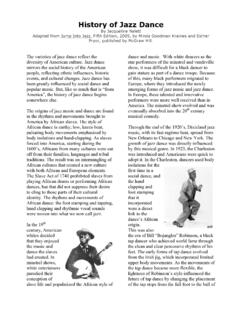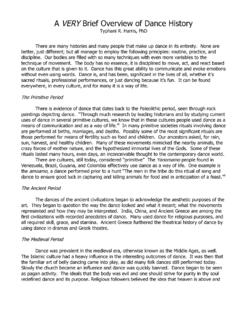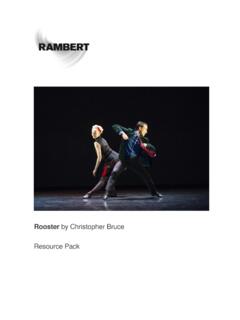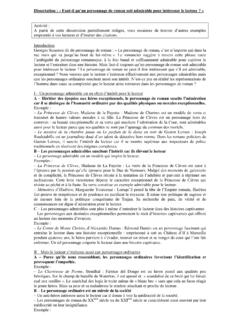Transcription of THE HISTORY OF MODERN DANCE - The Institute for Arts ...
1 THE HISTORY OF MODERN DANCE Ballet Austin s Michelle Thompson and Frank Shott Compiled and edited by Pei San Brown, Community Education Director, Ballet Austin The Pioneers of MODERN DANCE MODERN DANCE was born in America during the turn of the 20th century when a number of choreographers and dancers rebelled against the two forms of DANCE that were prevalent at the time, ballet and vaudeville. They rejected what they interpreted as the rigid and imperialistic nature of ballet, and they wanted to be taken seriously as artists rather than be seen simply as entertainers. Loie Fuller, Isadora Duncan, Ruth St. Denis, and Ted Shawn are considered to be the pioneers of MODERN DANCE in America. In 1891, Loie Fuller began experimenting with the effects of gas lighting on her silk costumes.
2 Fuller developed a form of natural movement and improvisation techniques that were used in Loie Fuller in La Danse Blanche circa 1896 conjunction with her revolutionary lighting equipment and translucent silk costumes. Fuller was an inventor and stage craft innovator who held many patents for stage lighting, including the first chemical mixes for gels and slides and the first use of luminescent salts to create lighting effects. Most of the movement was performed with the arms, as Fuller had minimal DANCE training. She emphasized visual effect rather than storytelling or expressing emotions. Considered the founding mother of American MODERN DANCE , Isadora Duncan was largely self taught. She presented her first recitals in 1898, and by 1900 she was in Europe, where she would spend most of her remaining life and win the greatest acceptance.
3 Duncan was truly revolutionary. She discarded the corset, slippers, and tutu of conventional ballet dress, adopting instead tunics that freed the body and revealed its movement. She used music by Chopin, Beethoven, Gluck, Wagner, and other first rank composers. Isadora Duncan at the Parthenon Theater She danced on concert stages and in opera houses. She spoke of her dancing not as entertainment but as art with a high moral purpose. Most of all, she insisted upon the essence of DANCE as movement. Her vocabulary was simple but performed with a musicality, dynamic subtlety, and charisma that made it powerfully expressive. In 1904, Duncan established her first school of DANCE just outside of Berlin, where she began to develop her theories of DANCE education and to assemble her famous DANCE group, later known as the Isadorables.
4 Between 1904 and 1907, Duncan lived and worked in Greece, Germany, Russia and Scandanavia. Ruth St. Denis was raised in a Bohemian environment and was encouraged to perform from a young age. She studied ballroom and skirt dancing, and was drilled in Delsarte poses by her mother. Her first professional job was as a variety act in 1894 at Worth s Family Theatre and Museum in New York. Important early influences were her work with the eminent director David Belasco, eastern spiritualism and imagery, along with European travel. She called her dances translations (ethnically inspired movement that included contemporary DANCE steps that became famous for their theatricality), which were inspired by Eastern cultures and mythologies including those from India and Egypt.
5 Ted Shawn in Mysteries of Dionysus By 1906 with Radha, St. Denis had found the essence of her distinctive DANCE style, which combined spiral form with equal parts voluptuousness, mysticism, and erotica. She built a stunning career as a soloist and, in 1914, acquired a professional and personal partner in Ted Shawn. A year later the two opened Denishawn which, as a school and company, nurtured leaders of the next wave of MODERN dancers, including Martha Graham, Doris Humphrey, and Charles Weidman. St. Denis was responsible for most of the creative work, and Shawn was responsible for teaching technique and composition. In 1933, Shawn founded his all male DANCE group, Ted Shawn and His Men Dancers, which was based at Jacob s Pillow farm in Massachusetts.
6 In 1939 St. Denis published her autobiography, An Unfinished Life. The First Generation of MODERN DANCE During the 1920s, a passion for interpretive dancing swept America. Isadora Duncan s fame and Denishawn s tours had introduced audiences and dancers alike to the concept of a new form of serious theatrical dancing. The ground work had been laid for the first generation of MODERN dancers, who began developing the art as we know it today. This first generation included Martha Graham, Mary Wigman, Hanya Holm, Doris Humphrey, Charles Weidman, Agnes de Mille, and Lester Horton. In 1916, Martha Graham began studying at Denishawn. During the next seven years, Graham evolved from a student, to a teacher, to one of the company s best known performers.
7 She often worked as Ted Shawn s partner, and became the co star of Xochtil, his famous duet about an Indian girl and an Aztec emperor. Martha Graham in Letter to the World (1940) In the late 1920s, Graham began working closely with Louis Horst, who she had known when he was the musical director at Denishawn. Horst introduced Graham to the work of Mary Wigman, the German MODERN dancer who studied with Jaques Dalcroze and then with Rudolf von Laban. The style of dancing Wigman evolved was, in her words, mostly dark, heavy, and earthbound. Her style was introduced to the United States in 1930 by her student, Hanya Holm. By 1930, Martha Graham had identified a new system of movement she called contraction and release, which was based on her own interpretation of the Delsartean principle of tension and relaxation.
8 This method of muscle control gave Graham s dances and dancers a hard, angular look that contrasted with the smooth, lyrical bodily motions of Isadora Duncan and Ruth St. Denis. Mary Wigman was the most highly regarded MODERN dancer and choreographer in Central Europe and one of the principal proponents of MODERN DANCE during the 1920s and 30s. Wigman s choreography often employed non Western instrumentation such as bells, gongs, and drums from Asia and Africa. However, the primary musical accompaniment for her most well known dances was percussion, which contrasted greatly with her use of silence. Wigman also utilized ecstatic spinning in her choreography. She was concerned with fundamental human emotions, relationships, and superstitions.
9 Influenced by non western and tribal motifs, Wigman s costumes were simple, made with dark rough fabrics, and often included masks. One of the legendary pioneers of American MODERN DANCE in the1930s, Hanya Holm was born in Germany and studied at the Dalcroze Institute . She studied in the 1920s with Mary Wigman in Dresden, eventually becoming a member of her company and chief instructor at her school. In 1931 Holm settled in New York to direct the Wigman Institute founded at the behest of Sol Hurok. In 1936, in response to rising antifascist sentiment, it was renamed the Hanya Holm School of DANCE . She choreographed successfully on Broadway with dances for Kiss Me, Kate (1948), My Fair Lady (1956), and Camelot (1960).
10 Holm s teaching emphasized space, and in choreographing, she made regular use of improvisation. Her theater work achieved a rare degree of dramatic and choreographic fusion. Doris Humphrey was a choreographic master, theoretician, and creator of the technique known as fall and recovery. She studied at the Denishawn school in Los Angeles, where her teaching and creative abilities were quickly recognized. In 1928 she left Denishawn and gave her first independent concert with Charles Weidman, with whom she formed the Humphrey Weidman Studio and Company in New York. From the start her work demonstrated an unerring sense of form, as well as an interest in large scale abstract works. Her book, The Art of Making Dances (1959), was based on her theories about DANCE composition.







